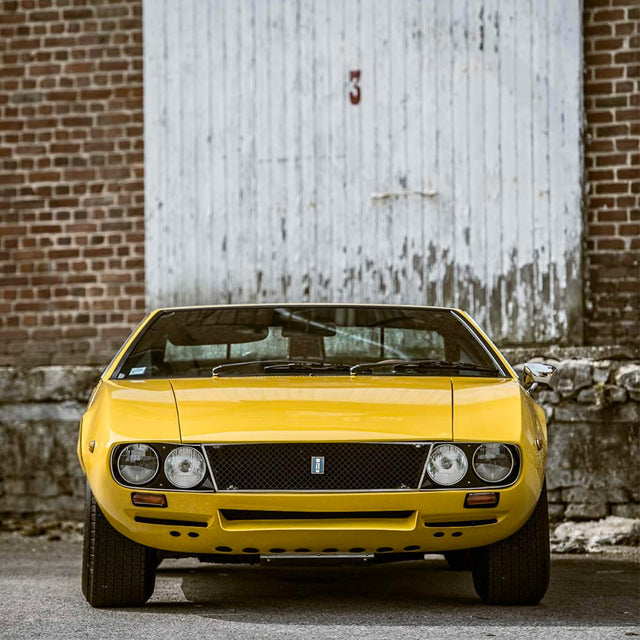Argentine-born racing driver Mr. Alejandro de Tomaso (1928-2003) immigrated to Italy in the 1950s. Continuing his chosen career, he initially drove OSCA race cars and later for the Maserati Brothers. His exposure to racing and the auto industry gave him the wherewithal, and presumed know-how to start his own company, and so De Tomaso Automobili SpA, was born in 1959. A producer of sports prototypes, and racing machines for others, his successful designs for Formula Junior, Formula 3, Formula 2, and Formula 1, would mean that Alejandro's company would prosper to the point where he could begin to realize a dream of building a sports car of his own. His first effort, the Vallelunga, appeared in 1965. Dirty Harry remarked, “a man has got to know his limitations”, and for Alejandro, it was engines. He never did produce his own, so the Vallelunga was powered by a 1.5-liter Ford four-cylinder engine, it was built in very small numbers, and was not commercially successful.
But it did contribute some of its ideas and engineering to his next effort. Following a template that had worked well for some in the past, and would be duplicated in the future by companies like Iso, Bizzarini, Jensen, and AC, De Tomaso’s next car would again mix a racing style chassis with European styling. Powering this combination would be American muscle, in this case again supplied by the Ford Motor Company, but in a much stronger flavor. The arrival of the Mangusta or “Mongoose” in 1967 gave rise to De Tomaso as bona fide sports car manufacturer.



Designed by a young Mr. Giorgetto Giugiaro for Ghia (of which De Tomaso had become president), the Mangusta featured muscular, wide-shouldered bodywork. Its signature feature is a center hinged gullwing-style rear window over the engine and luggage compartment, which rear outward visibility somewhat. An iconic Ford 289 cubic-inch V8 was placed in the middle. Also used to power the Shelby Cobra, and Ford's own GT40, it produced 306 horsepower in the Mangusta. In the US though, buyers had to settle for a Ford 302 cubic-inch V8 with a paltry output of just 221 horsepower. Testing showed the European-specification car would do the 0 to 60 mph dash in 6.3 seconds, through a 15-second quarter-mile at 94 mph, and then onto a claimed top speed of 155 mph. Both US and European delivery car’s utilized the GT40’s ZF gearbox, and other features included disc brakes on all four wheels, a four-wheel independent suspension, rack and pinion steering, and even air conditioning–although the output of said air conditioner was much like an asthmatic man trying to exhale. Other unintended features were horrendous build quality, low quality steel that would rust upon the mere mention of water, and a chassis that flexed too much.
Yes, like many other exotic cars from the era, the Mangusta has a reputation for "tempermental" handling and stability problems. The underdeveloped chassis is partly to blame, but the 32/68-weight distribution doesn’t help either. All cars with a powerful engine behind you have to be treated with care, and it's as equally true today as it was back then. The Mangusta is not impossible to drive, but does require attention and commitment. Other problems include a too-cramped cabin that was ergonomically challenged and had poor outward visibility. The Mangusta also has minimal ground clearance, making it difficult to cross almost any incline without scraping the underside. But it wouldn't be a super car after all without some "quirks."
Perhaps unfairly overshadowed by its successor, the more famous Pantera, the De Tomaso Mangusta is a beautifully-designed Italian exotic car that’s also very rare–only 401 examples were made between 1967 and 1972 in total, and it is estimated that only 250 have survived their own poor build quality and people who couldn’t drive them in anything but a straight line. So any Mangusta is bound to be exceedingly uncommon. It is interesting to note thatmangusta translates to “mongoose”, which is one of the few natural enemies of the cobra. Some say the name supposedly came about when Alejandro discussed the idea of replacing the Shelby Cobra with a racing car that would be built in Italy with Mr. Carroll Shelby. The deal didn’t happen, but De Tomaso went ahead with his own sports car. Many of the Magnusta’s issues won’t be deal breakers to collectors today, and it still has some great points going for it. Italian mid-engined supercar design with a powertrain that can be serviced at a Ford dealer? Check. ZF gearbox from the GT40? Check. Build quality? Not so much. But the cars can be restored to better than new today, and like its hybrid European-American brothers, super car connoisseurs appreciate them today.






































































